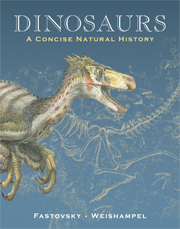Book contents
- Frontmatter
- Contents
- Why a natural history of dinosaurs?
- Dedication
- Part I Reaching back in time
- Part II Ornithischia: armored, horned, and duck-billed dinosaurs
- Part III Saurischia: meat, might, and magnitude
- Part IV Endothermy, endemism, and extinction
- 12 Dinosaur thermoregulation: some like it hot
- 13 The flowering of the Mesozoic
- 14 A history of paleontology through ideas
- 15 The Cretaceous–Tertiary extinction: the frill is gone
- Glossary
- Figure credits
- Index of subjects
- Index of genera
12 - Dinosaur thermoregulation: some like it hot
- Frontmatter
- Contents
- Why a natural history of dinosaurs?
- Dedication
- Part I Reaching back in time
- Part II Ornithischia: armored, horned, and duck-billed dinosaurs
- Part III Saurischia: meat, might, and magnitude
- Part IV Endothermy, endemism, and extinction
- 12 Dinosaur thermoregulation: some like it hot
- 13 The flowering of the Mesozoic
- 14 A history of paleontology through ideas
- 15 The Cretaceous–Tertiary extinction: the frill is gone
- Glossary
- Figure credits
- Index of subjects
- Index of genera
Summary
Chapter objectives
Vertebrate metabolic strategies
Reconstruction of past metabolic strategies
Potential dinosaur metabolism(s)
Scientific inference in a historical science
The way they were
Were dinosaurs cold-blooded, slow, and “reptilian,” or were they vibrant, active beasts capable of keeping up with the likes of birds and mammals? Our understanding of dinosaurs really hinges on this question.
Temperature talk
You can't use expressions like “warm-blooded” and “cold-blooded” and sound informed. In fact, most “cold-blooded” vertebrates have warm blood when they are active. So it's really about endotherms (endo – inside; therm – heat), organisms that regulate their temperature internally, and ectotherms (ecto – outside), organisms that use external sources of heat to regulate their temperatures.
In some organisms, called poikilotherms (poikilo – changing), temperature fluctuates, but in others, called homeotherms (homeo – same), the temperature remains constant. Humans are endothermic homeotherms: when we are unable to maintain our body temperature, we get sick. Ectotherms, such as lizards, can tolerate decreases in core temperature, while endotherms must internally regulate their core temperatures.
Temperature control is not the only issue in endothermic and ectothermic tetrapods. Indeed, more central is the very nature of metabolism itself, that is the sum of the chemical reactions in the cells of the organism, and the effect that the differences in endothermic and ectothermic metabolisms have on activity (Box 12.1).
Ectothermy and endothermy are two biochemically and biophysically different methods of obtaining heat.
- Type
- Chapter
- Information
- DinosaursA Concise Natural History, pp. 248 - 269Publisher: Cambridge University PressPrint publication year: 2009

